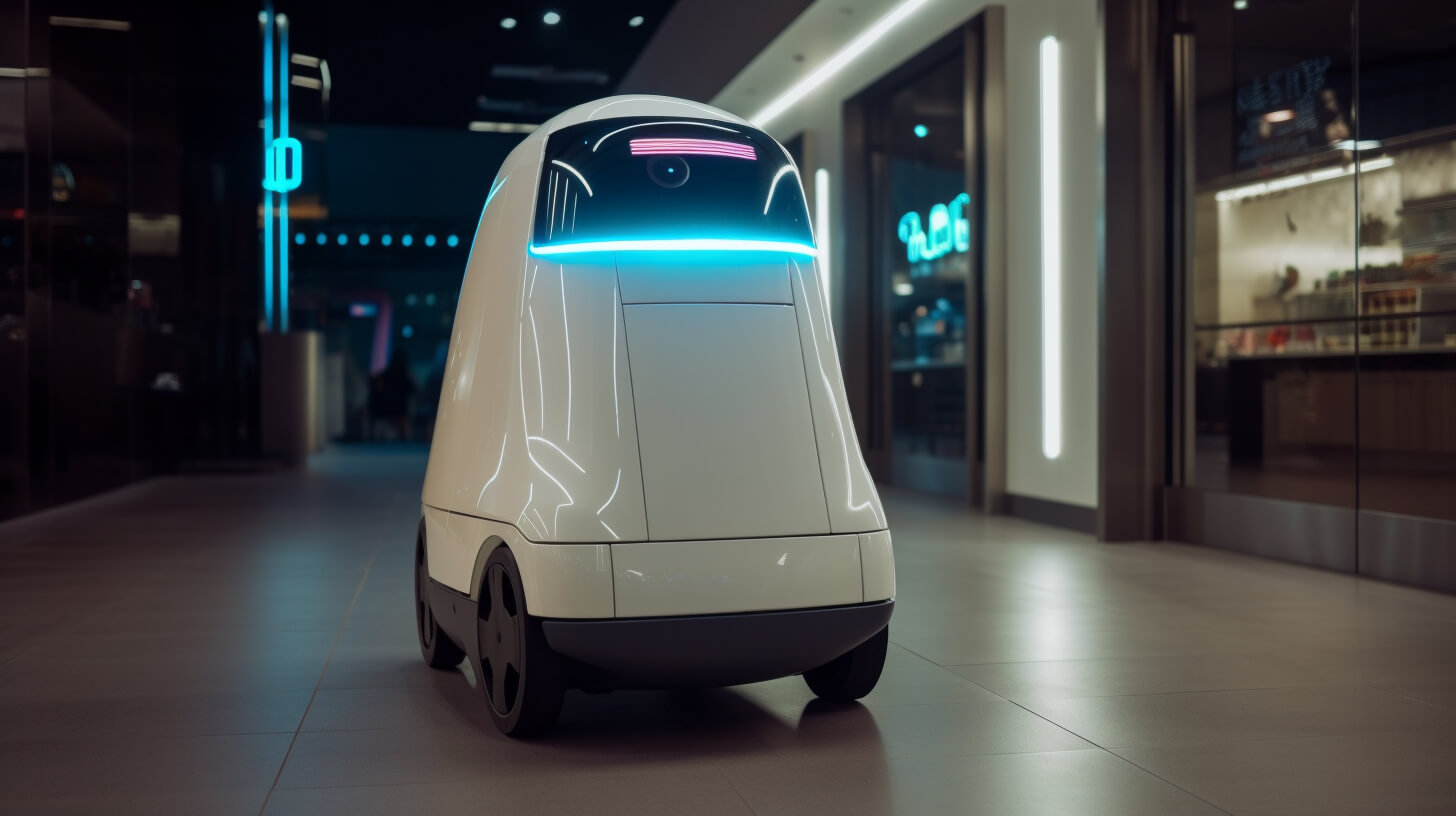
Airports are mini-cities with unique retail challenges: fast-changing foot traffic, sky-high passenger expectations, and tight turnaround times.
In this blog, game changing Digital transformations are specified on how Robotics & AI unlock real-time retail insights, from autonomous shelf scanners and indoor drones to cutting-edge AI for demand forecasting, planogram checks, smart pricing, and loss prevention.
Ready to learn how airport retailers can boost revenue and passenger experience with robots and AI?
Introduction
Airports aren’t just gateways for travelers. They’re buzzing micro-cities packed with retail opportunities. From luxury duty-free outlets to quick snack kiosks, these retail hubs generate billions annually. But running profitable retail operations in such dynamic, high-traffic spaces is far from simple.
Tight layover windows, unpredictable passenger flows, and strict security standards mean airport retailers must deliver speed, precision, and relevance, all while optimizing costs. Enter Robotics and AI: the game-changing duo transforming how airports approach real-time retail analytics.
Why Combine Robotics and AI at Airports?
Retail robotics in airports is about extending human capability:
- Robots and drones capture data quickly and safely.
- AI turns that data into insights — automatically.
- The result? Near real-time inventory accuracy, optimised merchandising, smarter operations, and happier travellers.
Key Retail Use Cases at Airports
Let’s get practical. Below are the top use cases where robotics and AI add measurable value.
1. Autonomous Shelf Scanning
Scenario:
Autonomous robots navigate duty-free shops after hours, scanning shelves for out-of-stock items or misplaced products.
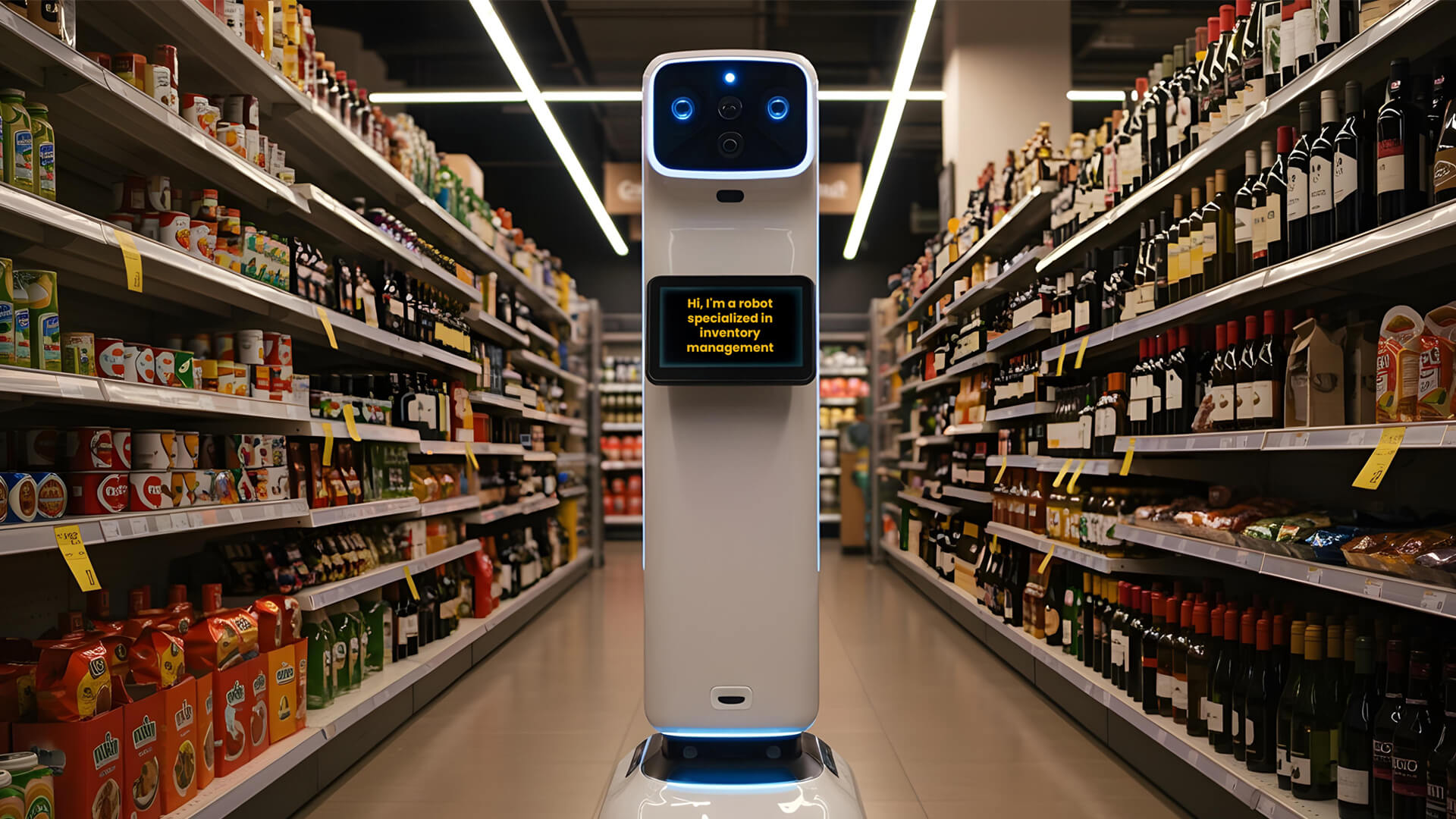
Key Robotics Tech:
- Robots: Shelf-scanning AMRs (Autonomous Mobile Robots) with 2D/3D cameras, LiDAR for navigation.
- Edge device: Devices with Common Unified Device Architecture or Coral TPU for CV, where the whole computer vision pipeline runs locally on an edge device
Technical Stack
Hardware
- AMR (Autonomous Mobile Robot) with mounted cameras (2D RGB + depth)
- Onboard compute for edge AI and robotics
Software & AI
- OS: ROS (Robot Operating System)
- CV Framework: PyTorch or TensorFlow (YOLOv8)
- OCR: OpenCV + Tesseract or ZBar
- Navigation: Simultaneous Localisation & Mapping (SLAM) – (Real Time Appearance Based Mapping or Cartographer)
SLAM is a key concept in robotics, autonomous vehicles when a device or robot needs to:
Localise itself → figure out its own position and orientation in an unknown environment.
Map the environment → build a representation (map) of the surroundings at the same time.
Connectivity
- MQTT or ROS topics for telemetry
- Secure Wi-Fi for cloud sync
Cloud
- Ingest raw scan images to S3/Data Lake
- Trigger serverless functions for validation (AWS Lambda/Azure Functions)
2. Passenger Flow Analytics
Robots, drones, or fixed cameras track passenger movements to understand:
- Which zones get the most footfall
- Where people dwell longest
- Which retail displays convert best
Key Robotics Tech:
- Robots with 360° cameras.
- Drones to cover wide concourses/open Areas/Spaces.
- Onboard or edge analytics.
Why YOLOv8 + DBSCAN?
Fast detection + noise-tolerant clustering — perfect for chaotic airport foot traffic.
Technical Stack
Hardware
- Ceiling cameras, robot-mounted 360° cameras, indoor drones
- Edge devices for Edge detection
Software & AI
- CV: YOLOv8 for people detection
- Trajectory: Python (OpenCV + DBSCAN in scikit-learn)
- Pose estimation (optional): OpenPose or MediaPipe
Connectivity
- RTSP streams → Edge → Kafka for big video streams
- Store anonymised footfall data in Data Lake
Cloud
- Use Spark for large-scale clustering
- BI: Tableau/Power BI for heatmap visuals
3. Visual Merchandising Compliance
Scenario:
Robots compare real shelf displays with planograms to check if promotions are correctly implemented.
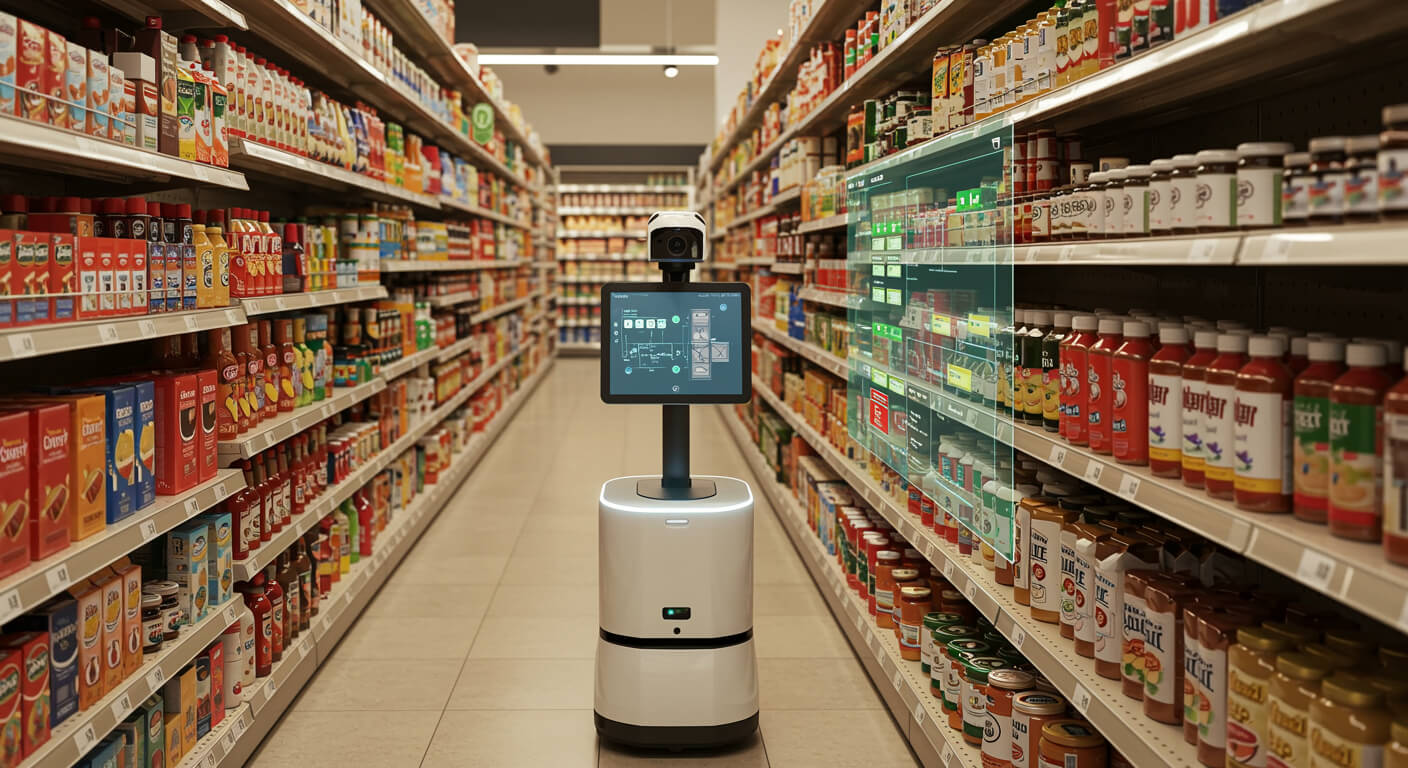
Key Robotics Tech:
- High-res shelf cameras mounted on AMRs.
- Optional drone fly-bys for signage and large displays.
Technical Stack
Hardware
- Same shelf robots + high-res cameras
Software & AI
- CV: PyTorch with Siamese Networks for image similarity
- Anomaly: TensorFlow Autoencoders for layout deviations
Connectivity
- ROS (Robotics Operating System) messages → Kafka topics → Cloud storage
Cloud
- Store compliance reports
- Trigger RPA bots to alert store managers
4. Smart Vending & Mobile Retail business
Scenario:
Autonomous vending robots roam gates, selling travel essentials based on predicted demand.
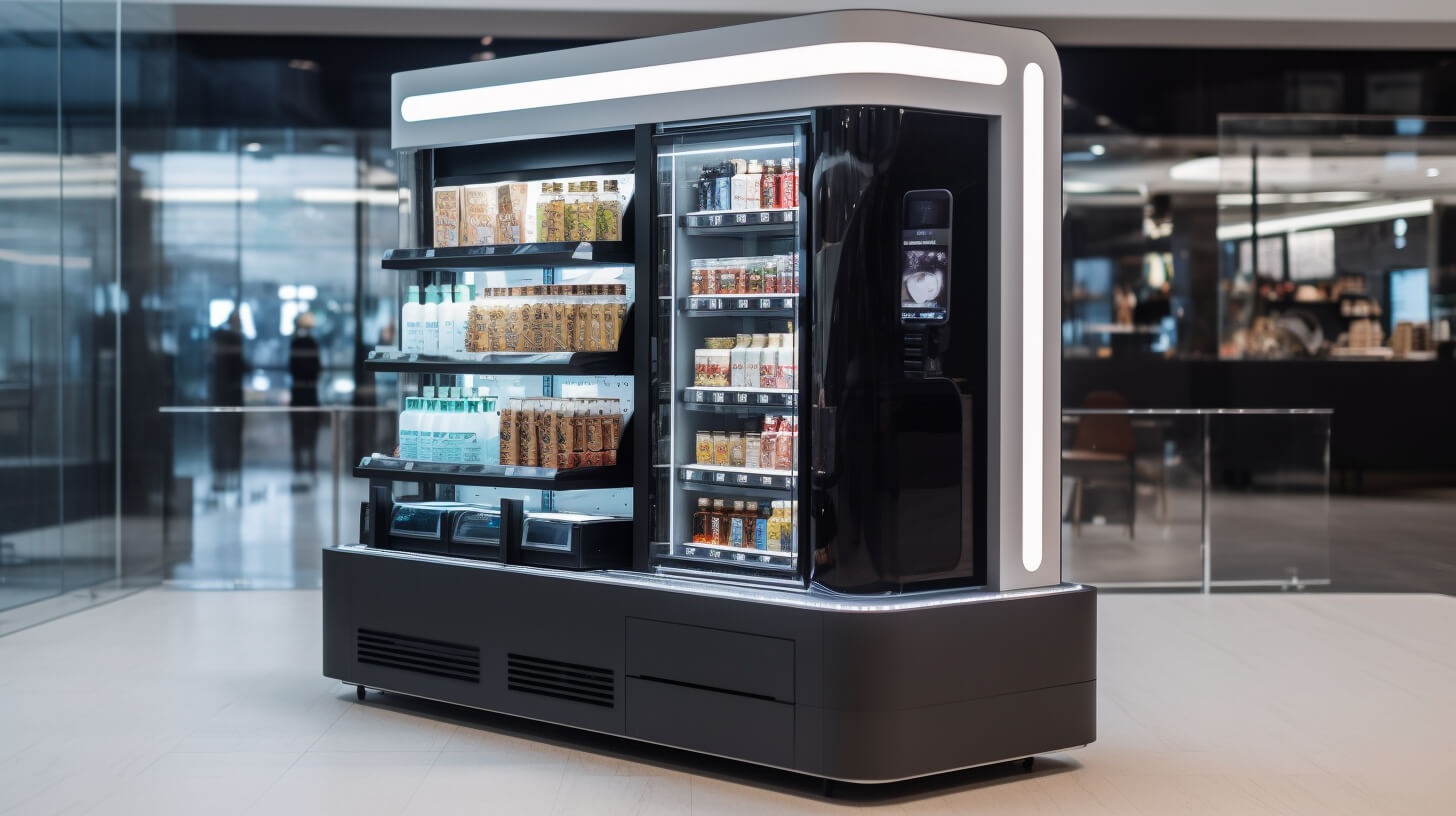
Key Robotics Tech:
- Small mobile robots with secure cashless payments.
- Sensors track inventory levels.
Technical Stack
Hardware
- Mobile vending bot with secured payment terminal (NFC- Near Field Communication)
- Stock sensors to monitor the tocks in real time, i.e RFID Tags, Smart Cameras, weight sensors, etc.
Software & AI
- Demand: LSTM in TensorFlow/Keras or PyTorch
- Pricing: Reinforcement Learning (Deep Q-Learning using Stable Baselines)
Connectivity
- Mobile 5G SIM for real-time payment
- MQTT for vending telemetry
Cloud
- Forecast pipeline: Airflow/Databricks
- Integrate with POS & inventory system
5. Conversational Robots for Customer Service
Scenario:
Robots with built-in screens or voice interfaces help travellers:
- Locate products.
- Get store hours.
- Answer FAQs in multiple languages.
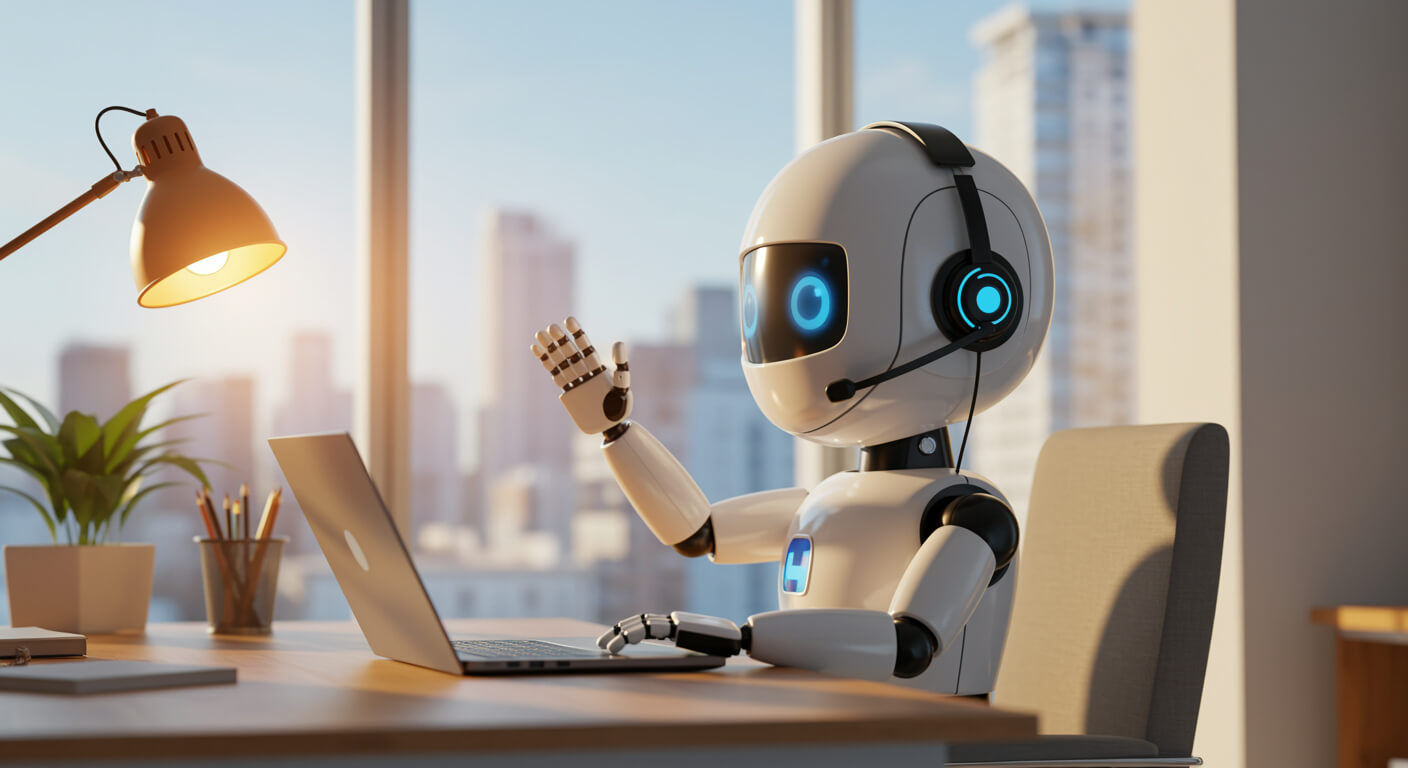
Key Robotics Tech:
- Autonomous or kiosk-style robot.
- Onboard mic + speaker.
Hardware
- Service robot (e.g., Softbank Pepper) with mic, speaker, screen
- Edge processor with GPU if local inference is needed
Software & AI
- NLP: BERT for intent detection, GPT-4 API for response generation
- Speech-to-Text: Wav2Vec2.0 (HuggingFace) or Google Cloud STT
- TTS (Text to speech): Google Cloud TTS or Amazon Polly
Connectivity
- HTTPS API calls to NLP backend
- Local fallback if no connectivity
Cloud
- RAG backend (LangChain) for store FAQs
- Logs for improving training data
6. Security Patrol & Loss Prevention
Scenario:
Robots patrol retail zones during closed hours, using AI to detect intruders or suspicious behaviour.

Key Robotics Tech:
- Indoor patrolling AMRs & robots for other OEMs.
- Thermal + HD cameras.
- SLAM for safe autonomous navigation.
Hardware
- Patrolling robot: (Boston Dynamics Spot or custom indoor AMR)
- Cameras: RGB + thermal
- Compute: Jetson AGX Orin for edge processing
Software & AI
- CV: YOLOv8 for real-time detection
- Anomaly: LSTM Autoencoder (PyTorch)
Connectivity
- Encrypted MQTT stream for patrol telemetry
- RTSP for video
Cloud
- Stream suspicious activity clips
- Trigger security alerts (via RPA)
| Layer | Typical Tools | Role |
| Orchestration | Airflow, Kubeflow Pipelines | Pipeline scheduling, workflow orchestration for ETL, ML, and pipelines. |
| Data Lake | S3, Azure Data Lake | Central storage for raw and curated structured/unstructured data. |
| Streaming | Kafka, MQTT, ROS | Real-time data ingestion, streaming, IoT event transport. |
| Model Registry | MLflow | Registering, versioning, and tracking ML models and experiments. |
| ETL | Spark | Transform, clean, and prepare data for analytics and ML. |
| Dashboards | Power BI, Tableau, Looker & other visualisation tools | Visualisation and business intelligence for stakeholders. |
| RPA Bots | UiPath, Automation Anywhere | Automate repetitive business processes, trigger workflows. |
How It All Fits Together: Technical Architecture
1. Robots & Drones Layer
- Mobile robots for scanning, vending, and patrolling.
- Indoor drones for large coverage.
- LiDAR, SLAM, obstacle avoidance for safe navigation.
2. Edge Processing
- Real-time CV runs on NVIDIA Jetson or Coral TPU inside robots.
- Lightweight CV (YOLOv8, ZBar) for barcode & object recognition.
3. Streaming Layer
- MQTT/RTSP streams video, telemetry to edge gateways.
- Kafka for larger video/event pipelines.
4. Cloud ML Layer
- ETL to clean/store data.
- ML models (LSTM, DQN, Siamese) run in the cloud.
- MLOps: MLflow or Kubeflow for versioning/retraining.
5. Integration Layer
- APIs push insights to ERP, POS, loyalty systems.
- RPA bots automate reordering, compliance reporting, and tax paperwork.
6. Visualization Layer
- Dashboards (Power BI, Tableau) for store managers.
- Real-time alerts for floor staff.
Benefits: What Do Retailers Gain?
- Real-Time Inventory Accuracy
- Reduced Labor Cost for Routine Checks
- Better Shelf Compliance & Promotions ROI
- Optimised Pricing & Stock Levels
- Data-Driven Layout & Placement
- Improved Passenger Experience
- Fewer Losses & Higher Security
Key Challenges to Manage
- Battery life: Short drone flights need smart scheduling.
- Indoor GPS: Robots rely on SLAM or beacons indoors.
- Data Privacy: Especially for video + face data.
- Integration: Must connect with legacy ERP/POS.
- Regulations: Airport security approvals for drones & patrol bots.
Airport Retail Robotics + AI: Technical Architecture Diagram
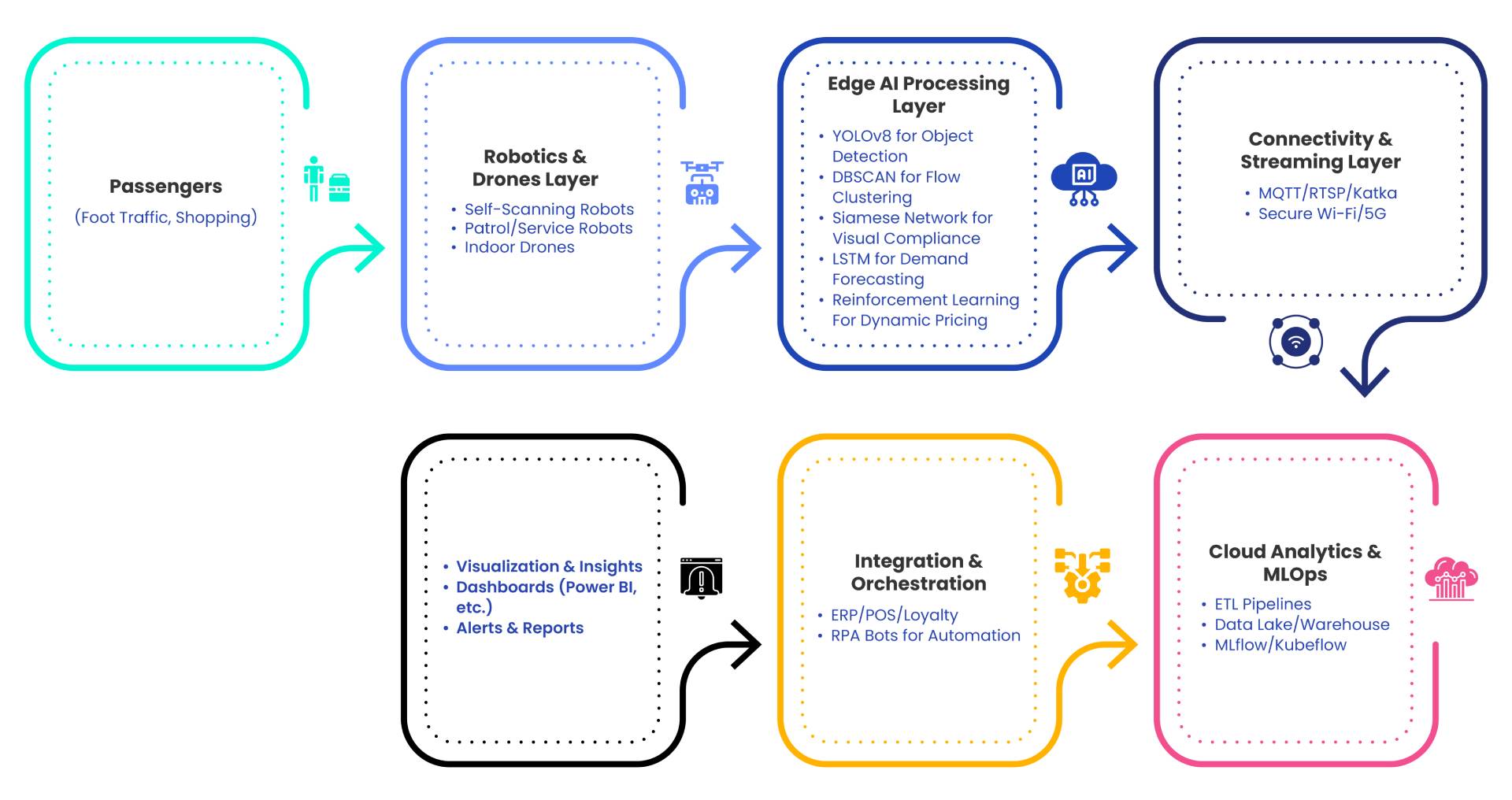
- Visualization & Insights
- Dashboards (Power BI, etc.)
- Alerts & Reports
Key Flow:
Passengers → Robots/Drones collect → Edge AI → Streaming → Cloud AI → Insights → Action
Some of the Key Use Cases for Robotics in Stores are mentioned below for reference. The following stores use a similar Technical stack mentioned above.
Inventory Management
- Shelf-scanning robots: Mobile robots roam store aisles to check stock levels, identify misplaced items, detect out-of-stock products, and verify price tags.
- RFID robots: Automate RFID scanning to track inventory accuracy.
Customer Assistance
- Service robots: Help customers find products, answer FAQs, or guide them through the store.
- Interactive kiosks: Some robots combine screens with mobility for a more engaging experience.
Cleaning & Sanitation
- Autonomous floor scrubbers: Robots clean large retail floors without human intervention, freeing up staff for higher-value tasks.
- UV disinfection robots: Used to sanitise store surfaces after hours.
Order Fulfilment & In-store Logistics
- Picking & sorting robots: In large-format stores or hybrid stores (e.g., Walmart or Target), robots help pick online grocery orders.
- Stock movement: Robots transport goods from backrooms to shelves or staging areas.
Security & Monitoring
- Security patrol robots: Monitor store premises after hours or during open hours to deter theft and check for hazards.
Benefits for Retailers
- Improved inventory accuracy
- Lower operational costs
- Higher staff productivity (staff spend more time with customers)
- Faster restocking and online order fulfilment
- Enhanced store cleanliness & safety
Challenges
- High upfront costs
- Integration with existing systems
- Workforce acceptance & training
- Reliability in busy, unpredictable environments
Where It’s Heading
- More AI integration (computer vision, NLP).
- Human-robot collaboration (staff working alongside robots).
- Smaller, more specialised robots for niche tasks.
- Tighter link with supply chain and smart shelves.
“Airports are the ultimate stress test for retail — tight deadlines, unpredictable crowds, and high stakes. Robotics and AI empower airport retailers to see, analyse, and act in real time — creating smoother operations and better shopping experiences for travellers on the go.”
Ready for Lift-Off?
If you’re an airport retail leader, start exploring robotics + AI pilots today. Combine the right use cases, smart robots, edge AI, and robust data pipelines to future-proof your retail operations — from shelf to gate. For more details on the algos to be used, please reach out to us.

